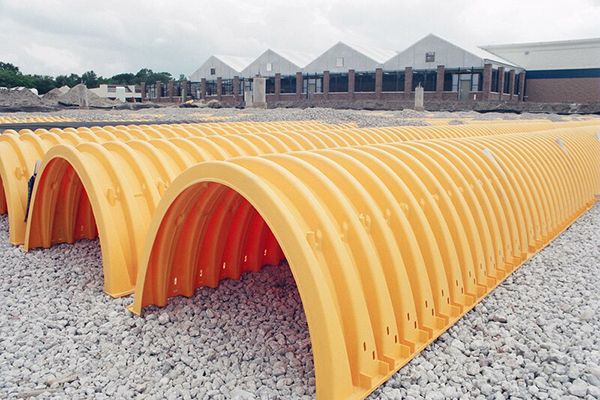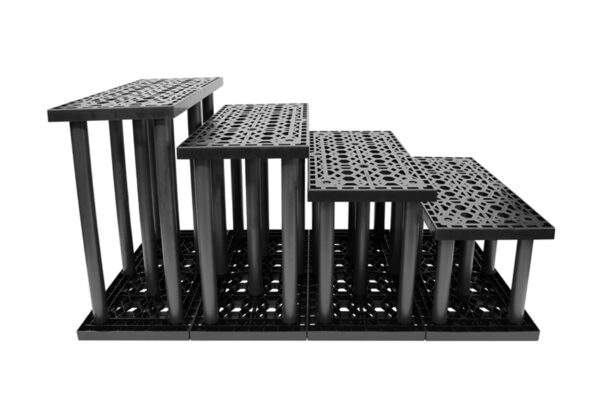Low impact development (LID) is an innovative approach to urban and suburban development that aims to mitigate the negative environmental impacts of traditional land development. This type of development is designed to work in harmony with the natural environment, rather than against it, by reducing stormwater runoff, preserving natural habitats, and minimizing the use of non-renewable resources.
Mitigating Stormwater Runoff
Stormwater runoff is a major environmental issue in many urban and suburban areas. Traditional land development practices often involve the installation of impervious surfaces such as concrete and asphalt, which prevent rainwater from being absorbed into the ground. This can result in increased stormwater runoff, which can lead to flooding, erosion, and water pollution. Low impact development (LID) offers a solution to this problem by incorporating infiltration, retention and detention in underground stormwater storage systems to help reduce stormwater runoff.
Low Impact Development Solutions: Underground Stormwater Management
Underground stormwater storage systems are effective ways for municipalities and private land developers to adopt low impact development (LID) best practices. Underground arch chambers and modular tank systems are the two best options available for underground stormwater management.
They incorporate either an impermeable geomembrane or a permeable nonwoven geotextile depending on if the system is meant for infiltration, retention or detention.
Infiltration
Infiltration is an essential component of underground stormwater management systems. Infiltration-focused applications include nonwoven geotextiles around the chamber or tank and the granular stone at the excavation line. This allows the water to be stored in a temporary basin for it to percolate down into the bedding layer and native soils to recharge the groundwater.
Retention
Retention-focused systems include an impermeable liner either wrapped around the chamber or tank or wrapped around the granular material. This prevents infiltration for various reasons, including concern over contaminated soil or the presence of groundwater. This method allows for rainwater harvesting to be used for irrigation.
Detention
Detention is meant to slow the release of water and reduce peak runoff downstream based on the outlet or orifice sizing. This type of application may or may not include an impermeable geomembrane.
Underground Stormwater Systems vs. Stormwater Ponds: The Conventional Solution Could Be Hurting Your Budget
Efficient stormwater management is essential in areas of urban and suburban development. Stormwater ponds can be a viable solution for specific areas where land is more available and less valuable. However, underground stormwater management systems are becoming more common in areas where available land is limited, and developers must make efficient use of the land that is available. In densely populated and/or rapidly growing cities, underground stormwater management systems are the only viable option.
Although stormwater ponds can be more cost effective to build, it’s important to identify three major problems with retention ponds:
- They’re an inefficient use of land, taking up more space than underground systems. Large or rapidly growing cities can’t afford to use more land than necessary for development.
- Despite having lower installation costs, the cost to maintain a stormwater pond is significantly more expensive than an underground system. Dewatering and excavating a pond costs hundreds of thousands of dollars, and this maintenance is required at least once a decade.
- Uncontrolled evaporation, higher temperatures and odours lower water conservation efforts and reduce water quality.
For growing urban and suburban communities, the space and maintenance stormwater ponds require is not worth the initial cost savings of installation.
Benefits of an underground stormwater management system:
- More efficient use of space in urban or suburban areas where land is at a premium.
- Reduced maintenance costs.
- Reduced the risk of water shortages during periods of drought, protecting water resources.
Selecting the Best System: Arch Chambers and Modular Tank Systems
Arch chambers and modular tank systems are the two main options available for underground stormwater management solutions. While both options effectively save valuable land space and protect water resources by adhering to low impact development standards, there are key factors required for every application that must be considered:.
- The site space available
- The volume of stormwater
- The amount of material that will be removed during excavation
- The amount of clear stone that must be imported
Looking at the project cost as a whole will help determine which option to select. Generally, modular tanks will have higher assembly and placement costs due to specialized installation requirements. Arch chambers will have higher material costs due to a larger excavation and higher amount of clear stone required.
“If you’re just comparing plastic to plastic, there may be substantial cost savings left undiscovered.”
– Amy Woods, Technical Product Manager.
Arch Chambers
Arch chambers are made of polypropylene and feature an open bottom. They are placed in parallel rows in conjunction with geotextiles, clear stone and geomembranes (if applicable).
Key Benefits and Features:
- Suitable for major commercial construction and smaller residential or highway stormwater drainage applications.
- Structurally durable; 75-year design life.
- Suitable for infiltration, retention, rainwater harvesting, and runoff reduction.
- Can be used to enhance green infrastructure such as permeable pavement or rain gardens.
- Designed to ASTM & AASHTO specifications.
- Stormwater quality through patented isolator® Row (TSS, TP and TPH removal).
- Reduction of thermal impacts.
Modular Tanks
Modular tank systems are comprised of strong PVC and Polypropylene boxes that are assembled side by side to create a subsurface tank. They are applied in conjunction with geotextiles, clear stone and geomembranes (if applicable).
Key Benefits and Features:
- Suitable for major commercial construction and smaller residential stormwater drainage applications.
- Largest void space of any subsurface stormwater management system, providing as much as 97%. (Minimal granular stone required for installation, allowing for maximum volume of water).
- Uniform load distribution and strength.
- Suitable for infiltration, retention, rainwater harvesting, and runoff reduction.
- System stack ability and variable column height accommodate tight site constraints.
- Can be used in submerged groundwater conditions.
- Can be used to enhance green infrastructure such as permeable pavement or rain gardens.
- Designed to ASTM & AASHTO specifications.
Suitable Applications for Arch Chambers and Modular Tank Systems:
- Stormwater runoff reduction
- Water sustainability
- Rainwater detention
- Underground stormwater retention
- Underground stormwater infiltration
- Rainwater harvesting
- Enhancing green infrastructure
Installation Requirements
Although both arch chambers and modular tank systems offer a viable solution for underground stormwater storage and filtration, the installation requirements of modular tanks can offer significant costs savings for the right applications.
Modular tank systems provide the following benefits over arch chambers:
- Higher void space = lower footprint
- Less clear stone required = cost savings in materials & labour + lower footprint
- Can take more direct connections to manifold pipes
- Less fabric and textile required = cost savings
As regulations for underground stormwater storage increase, using a system that requires less space becomes more of an economical option. Modular tank systems offer an opportunity to reduce the size of the excavation and the amount of clear stone required, providing significant cost savings for project owners as well as a more structurally advanced solution.
Project Consultation & Design Assistance
Site-specific design is crucial for incorporating the correct underground stormwater solution into specs. Every application presents unique challenges that must be addressed in your design. Underground stormwater solutions perform exceptionally well when the correct system is selected for an application. They offer urban and suburban developers long-term low impact development solutions that will enhance the functionality of a city’s stormwater management approach.
Learn more about our underground stormwater solutions here.
Let’s Work Together
Our top priority is your project success. If you’re interested in learning how to specify an underground stormwater solution in current or future designs for optimal performance, or you already know your project requirements and need pricing, get in touch with us!
Request a consultation or a quote below.



